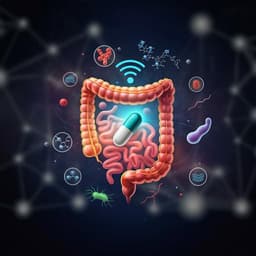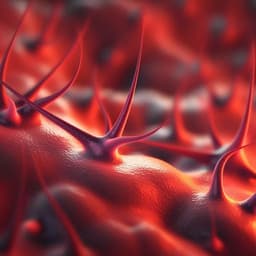
Engineering and Technology
Self-healable stretchable printed electronic cryogels for in-vivo plant monitoring
E. Bihar, E. J. Strand, et al.
This study showcases innovative implantable printed electronics that integrate highly conductive inkjet-printed PEDOT:PSS traces within PVA cryogel matrices, leading to biocompatible electronic cryogels. These flexible, self-healing materials successfully monitored ionic activity within tomato plant stems for over two months, demonstrating their potential for long-term applications in plant tissues. Research conducted by Eloïse Bihar, Elliot J. Strand, Catherine A. Crichton, Megan N. Renny, Ignacy Bonter, Tai Tran, Madhur Atreya, Adrian Gestos, Jim Haseloff, Robert R. McLeod, and Gregory L. Whiting.
~3 min • Beginner • English
Introduction
The study addresses the challenge of creating robust, biocompatible electronic interfaces with living tissues—specifically plant stems—for long-term monitoring of physiological and environmental signals. Conventional substrates (e.g., PET, PEN, yarns) and fabrication methods can induce necrosis in plant tissues and limit implant longevity. Soft, tunable, biocompatible materials such as cryogels offer a promising route to match the mechanics of biological tissues and reduce adverse responses. The authors propose integrating inkjet-printed PEDOT:PSS electronic traces into physically crosslinked PVA cryogel matrices to produce stretchable, self-healable, and stable implantable devices, including electrodes and OECTs, capable of prolonged in vivo operation within plant stems. The purpose is to enable continuous, minimally invasive, in-situ monitoring of plant health and environmental conditions while mitigating wound responses and maintaining device performance over time.
Literature Review
Recent advances in soft and biointegrated electronics include e-skins, tattoo-like sensors, and transient implants for health monitoring and treatment. For plants, OECTs, organic ion pumps, and bioristors have been used to measure physiological changes in sap, but common substrates can cause necrosis and impede long-term monitoring. Fabrication techniques like photolithography or blade coating limit patterning flexibility. Cryogels—hydrogels formed by freeze–thaw cycling—are biocompatible, tunable, and have macroporous structures with shape memory, suitable for mimicking tissues such as skin and plant stems. PVA cryogels, formed via physical crosslinking without cytotoxic agents, are cost-effective and biodegradable. Incorporation of conducting polymers into hydrogels has been demonstrated; PEDOT:PSS stands out for biocompatibility, chemical stability, and aqueous processability, and has enabled self-adhesive, conductive composites and self-healing behaviors in related systems. Prior plant-interface examples include thermogel-based morphable electrodes and conformable hydrogel electrodes, but these approaches often support only short-term implants and struggle with growth-induced deformation. The present work builds on this foundation to realize long-term, stretchable, self-healing cryogel-based printed electronics for plants.
Methodology
Materials and inks: PEDOT:PSS (Clevios F.H.C.) was mixed with 1 wt% GOPS for crosslinking. Inks (1–1.5% PEDOT:PSS, 8–70 mPa·s pre-GOPS) were sonicated 30 min and filtered (1.2 µm PTFE). PVA (various MW: 31–50k, 89–98k, 146–186k g·mol⁻¹) was dissolved in DI water at 90 °C at weight ratios (H2O:PVA) of 100:5, 100:10, 100:20. For capacitors, PVA and H3PO4 in DI water were used.
Fabrication: PEDOT:PSS traces (lines, interdigitated electrodes, and OECT gate/channel) were inkjet-printed (Dimatix DMP-2800; 15 µm drop spacing; platen 50 °C; ink 30 °C) with three wet-on-wet layers, then dried at 90 °C for 10 min. A first PVA gel layer (e.g., 100:10 H2O:PVA, MW 89–98k) was drop-cast atop the printed traces and air-dried ~6 h, then peeled from glass. A second PVA layer (e.g., 100:20; MW 89–98k) was deposited locally over the sensing region. Physical crosslinking by cryogelation was performed via freeze–thaw cycling: samples were frozen at −20 °C (e.g., overnight), thawed, and a second FT cycle applied. Geometry variants included straight and serpentine/spring-shaped traces to enhance stretchability.
Characterization—mechanical: Tensile tests used an MTS Insight 2 with 2 kN load cell; failure speed 30 mm·min⁻¹. Typical specimen dimensions (L×W×T): cryogels 5.75×0.127×0.3175 cm³; air-dried gels 5.75×0.127×0.0175 cm³. Rheology (Anton Paar MCR 702e) assessed viscosities (see Supplementary data). Self-healing tests involved cutting samples with a razor, bringing cut faces into contact (<10 s), and monitoring recovery at room temperature over 15 min to 48 h; one piece was stained for visualization.
Characterization—electrical/electrochemical: Resistance under strain (including 100-cycle 10% cyclic tests) was measured for line vs serpentine traces in air-dried vs cryogel matrices. Capacitors (interdigitated) were tested by cyclic voltammetry (CV; 0–1 V; scan rates 20–50 mV·s⁻¹) and galvanostatic charge–discharge (1–100 µA) using BioLogic SP-150 and EmStat3 Blue. Specific capacitance was computed from CV integrals normalized by electrode mass. SEM (Hitachi TM4000Plus II) examined porosity and structure.
OECTs: Device areas: gate 2.5×2.5 mm²; channel 2×1 mm²; gel thicknesses ~0.175±0.025 mm (air-dried) and 0.30±0.05 mm (cryogels); implants ~300±50 µm thick. Keithley 2600 SMU measured transfer and transconductance (Vd 0 to 1.2 V; Vg −1.2 to 0 V). Chronoamperometry used 30–60 s gate pulses (0–0.5 V) with Vd held (e.g., −0.8 V in benchtop tests). Thin Ag wires were attached to contacts.
Plant growth and implantation: Red cherry tomato (Solanum lycopersicum) grown hydroponically (Idoo) under 16 h:8 h light–dark, 24 W LED, 21 °C, 30–50% RH; weekly diluted hydroponic fertilizer during growth. Devices were implanted in stems via longitudinal cuts; at least 7 days post-implantation elapsed before measurements to reduce acute wound effects. For nutrient uptake studies, roots were kept initially in tap water, then exposed to 300 mM KCl after 7 days. Drought studies removed water for 24–44 h.
Impedance spectroscopy: EmStat Pico over 22 Hz–200 kHz with 100 mV AC to avoid Faradaic artifacts. Randles-type equivalent circuit used for interpretation (series solution/contact resistance plus parallel charge-transfer/double-layer elements), with additional diffusion contributions expected from permeable PVA.
Histology and imaging: Hand-sectioned stems stained with 0.01 wt% toluidine blue, rinsed (10% ethanol, then DI water), and imaged optically. X-ray computed tomography (ZEISS Xradia 520 Versa; 60 kV, 5 W; 0.4× objective; 1201 projections; binning 2) was performed after soaking stem segments in 10 wt% cesium iodide for 15 h. Twenty stems were implanted and monitored up to ~81–120 days.
Key Findings
- Fabrication of inkjet-printed PEDOT:PSS traces embedded in physically crosslinked PVA cryogels yielded biocompatible, freestanding electronic cryogels with improved aqueous stability; implanted devices retained 97 ± 2% of original weight after 14 days in vivo in tomato stems and maintained electrical function in aqueous media.
- Mechanical tunability: Cryogels exhibited Young’s modulus in the kPa range (≈1.74 kPa for formulated cryogels) with high ductility; elongation increased from ~70% (air-dried gels) to >300% (up to 330% depending on PVA MW, concentration, and FT conditions). Porous sponge-like microstructures were observed and were tunable via FT parameters.
- Electrical under strain: Serpentine (spring-shaped) PEDOT:PSS traces in cryogels showed reduced resistance change under deformation compared to line traces. For serpentine traces, R/R0 ≈ 1.45 up to 100% strain, demonstrating superior strain tolerance. Under 100 cycles at 10% strain, cryogel traces were mechanically and electrically stable.
- Conductivity and device performance: Embedded PEDOT:PSS traces exhibited high conductivity up to 350 S·cm⁻1. Interdigitated capacitors displayed planar capacitive behavior with specific capacitance up to 4.2 mF·g⁻1; serpentine-printed capacitors stretched to ~160% before failure and retained ~60% of initial capacitance at 100% strain (vs ~30% retention at 60% strain for solid-state comparators). Linear charge–discharge profiles confirmed capacitive behavior.
- Self-healing: Reducing freezing time (e.g., to 30 min) improved self-healing by lowering crosslink density. Pure cryogels regained up to ~155% strain capacity after 48 h healing (~66% of pristine). For electronic cryogels, a cut serpentine trace recovered from 9 kΩ (intact) to 13 kΩ after 15 min of reconnection, decreasing to 11 kΩ after 2 days; healed samples stretched to ~175% before rupture with an electrical resistance loss ratio of ~5.3 under strain.
- Biocompatibility and tissue response: Histology showed limited lignification and wound response compared to cut-only controls. After 2 weeks, narrowed/elongated pith cells were observed with limited lignification; by 30 days, a callus formed around xylem at the wound interface. X-ray CT at 1 week and 1 month corroborated reduced immune response with implants.
- In vivo impedance monitoring: Implanted cryogel electrodes provided stable impedance in water over time. Upon switching roots from water to 300 mM KCl after 7 days, stem impedance decreased over ~1 h consistent with increased K+ in sap; an initial small increase (~+9 kΩ at 995 Hz in first 10 min) was observed, consistent with transient water loss reversing xylem flow. Control water-to-water transfers showed minimal change (~+1 kΩ). Under drought (24–44 h without water), impedance increased substantially (e.g., up to +3140 kΩ at 995 Hz after 24 h), indicating reduced ion mobility and increased barriers at the electrode interface.
- OECT sensing in stems: Cryogel OECTs implanted in stems exhibited maximum transconductance of 1.41 mS on day 1, remaining 1.17 mS (82% of initial) at day 62 and measurable up to 82 days. OECT response decreased with increasing channel–gate separation (5.7, 9.5, 15 cm). During KCl exposure, drain current variations tracked ion uptake in real time, consistent with impedance results. Limit of detection for K+ in benchtop ionic-gel tests was ~50 µM; crosslinking (cryogel) was essential for stability despite slightly lower gm vs air-dried gels.
Discussion
Embedding printed PEDOT:PSS within physically crosslinked PVA cryogels produced soft, stretchable, and self-healable electronic implants that match the mechanics of plant tissues and remain stable in aqueous environments. This addresses the central challenge of forming long-term, minimally invasive plant–electronic interfaces without inducing substantial necrosis or scar (lignified) tissue that would impede signal collection. The tunable porosity and low modulus of cryogels, alongside robust electrical performance under large strains and repeated cycling, enabled durable electrodes and OECTs. The in vivo studies demonstrate that these implants can noninvasively track physiological changes: impedance spectra sensitively reported nutrient uptake (KCl) and water stress (drought), while OECTs amplified ionic dynamics in sap, offering time-resolved monitoring over months. Limited lignification and callus formation relative to cut-only controls underscore biocompatibility and reduced immune response. Overall, the results validate cryogel-based printed electronics as a reliable platform for continuous, in-situ plant health monitoring and environmental sensing, overcoming limitations of rigid substrates and short-lived interfaces.
Conclusion
The work demonstrates a scalable method to integrate highly conducting inkjet-printed PEDOT:PSS with biocompatible PVA cryogels, yielding stretchable, self-healable, and long-term stable implantable devices for in vivo plant monitoring. Devices achieved high conductivity, large strain tolerance, recoverability after damage, and robust electrochemical performance, enabling continuous monitoring of ionic activity and water-stress conditions in tomato stems for over two months with minimal tissue lignification. These capabilities position cryogel-based printed electronics as promising tools for precision agriculture and environmental monitoring. Potential future research includes: optimizing cryogel crosslinking and composition for faster self-healing and lower interfacial impedance; integrating multiplexed sensor arrays and additional modalities (e.g., chemical specificity) across diverse plant species and tissues; refining device geometries and encapsulation for growth-induced deformation; and advancing circuit-level integration for on-plant signal processing and wireless data collection.
Limitations
- Self-healing of electronic traces required precise mechanical alignment of thin printed conductors on thicker gel substrates; misalignment can limit electrical recovery.
- Crosslink density affects both mechanical robustness and healing; optimizing FT parameters involves trade-offs between modulus, toughness, and reparability.
- Cryogel OECTs exhibited slightly lower transconductance than air-dried counterparts, though necessary for operational stability in biological media.
- Over long durations, partial performance decline was observed (e.g., OECT gm decreased to ~82% by day 62), likely due to progressive tissue changes (lignification) at the interface.
- High salt stress (repeated 300 mM KCl exposures) showed indications of plant damage by day 25, affecting impedance modulation and potentially confounding sensor readouts.
- Equivalent-circuit interpretation is complicated by ion diffusion through the permeable hydrogel substrate, adding uncertainty to parameter attribution.
Related Publications
Explore these studies to deepen your understanding of the subject.







